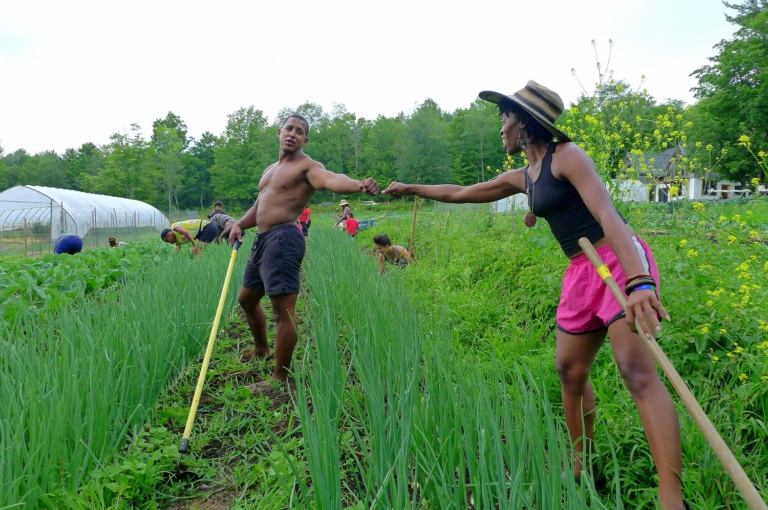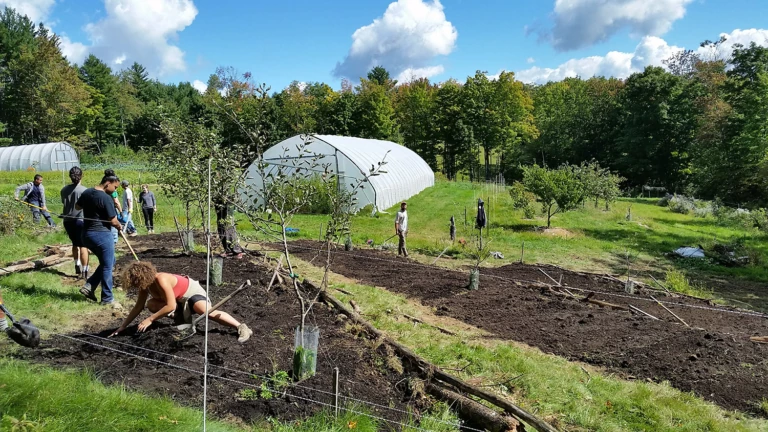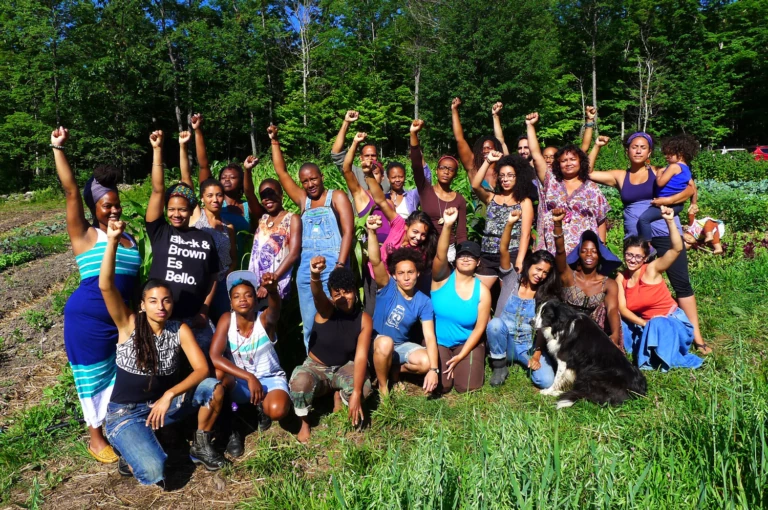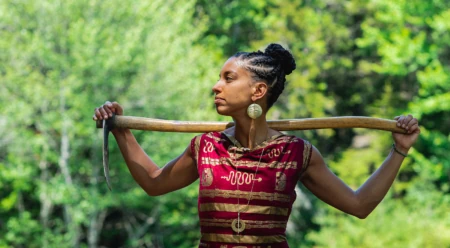Liberation on the Land
Leah Penniman is the cofounder of Soul Fire Farm in Grafton, New York, where she works toward her commitment “to ending racism and injustice in our food system by increasing farmland stewardship by people of color, promoting equity in food access and training the next generation of activist farmers.” She published Farming While Black (Chelsea Green) in 2018—the first comprehensive manual for African-heritage people ready to reclaim their rightful place in the food system. Penniman’s vast research and historical acuity make this book much more than a how-to guide for small-scale farmers; by exploring ancient African farming methods, the atrocities of slavery and the current landscape of “food apartheid,” Penniman shows how racial injustice, climate change and our alienation from nature are connected—and how healing ultimately starts in the soil.
Leah graciously took time away from farming, teaching and writing to answer my questions about her farm, book, activism, regenerative agriculture and visions for the future.

Fist bump between two participants in Soul Fire Farm’s Black Latinx Farmers Immersion, a weeklong, rigorous introduction to small-scale sustainable farming that balances the nerdy explication of concepts like “soil cation exchange capacity” with the cultural and historical teachings necessary for Black and Brown people to heal their relationships to land. Photo: Leah Penniman
Jeff McElroy: In your mission to empower Black and Latinx farmers, you advocate small ag and regenerative farming techniques over large, profit-driven agriculture methods. Can you explain the connection between ending racism and injustice in our food system, and regenerative agriculture?
Leah Penniman: In short, the way that we treat the sacred Mother Earth and the way that we treat our human siblings are interconnected. The fact that right now our food system is fundamentally based on stolen lands and exploitative labor is a grave injustice. We have a situation in the US where almost all the land that we use to cultivate food—98 percent of rural land—is owned by European-heritage people—no accident of history that began with the genocidal thefts of land from First Nations people and continued with the exclusion and expulsion of folks of color. At the same time, 85 percent of US food is grown by Latinx and Hispanic people, yet only about two percent of our farms are managed by folks in that demographic group.
[Food] apartheid is a human-created system of segregation, which is what we have right now, because of a history of redlining—government-sponsored housing discrimination and zoning regulations that prevented folks of color from integrating into neighborhoods outside of redlined neighborhoods for many generations. If you are a White person in this country, you are four times more likely to have a supermarket in your neighborhood than if you are a Black or Brown person. If you are a Black child, you have a one-in-three chance of going to bed hungry tonight as compared to a one-in-six chance for all children. This is not because we don’t know how to eat, it is not because we don’t desire to have good food, it’s really because of access.
So, we truly have an unjust food system and at the same time, our industrial agriculture is trashing the planet. We know it is a major driver of climate change, water withdrawals, land use conversion, pollinator destruction and so forth. A system that is inherently based on exploitation and a profit motive is not going to take care of humans or the earth. In contrast, regenerative agriculture is an ancient and modern solution to this problem because it centers on the life of the soil, the needs of our human and non-human relatives and provides a roadmap for healing.

Volunteers at a konbit (community work day) help build terraces on the sloped areas of the field. Terracing helps keep soil from washing away and results in higher crop yields. Photo: Leah Penniman
JM: Chapter four, “Restoring Degraded Land,” looks to ancestral African methods for revitalizing soil: terraces of Kenya, raised beds of the Ovambo people, no-till methods and cover cropping. Can you share your perspective on how going back to ancestral farming techniques can reverse aspects of the climate crisis?
LP: In the late 1800s, within one generation of settlers opening up the Great Plains for agriculture with the plow, those soils lost over half of their organic matter. Organic matter is carbon based; it is the life of the soil. Carbon belongs in the soil. When you till it, when you abuse it, that carbon goes up into the atmosphere and becomes a greenhouse gas—it becomes a driver of climate change. So, we saw the first spikes in the graphs of anthropogenic CO2 in the atmosphere in the 1800s around the tilling of the plains.
Ancestral farming techniques sequester carbon. They are “mitigators” of climate change and they are also strategies that make a farm adaptable to climate change. For example, using semi-permanent raised beds allows for flood mitigation. During Superstorm Sandy, farmers around us were losing topsoil due to water erosion, but we had minimal losses because the shallow pathways we’d dug between our raised beds infiltrated the water. Our decision to “mound” our soil literally saved our farm.

Black Latinx Farmers Immersion participants hanging onions to cure in the barn. Photo: Leah Penniman
JM: You designed the technical information in Farming While Black “for farmers and gardeners with zero to five years of experience.” What are the most important things these folks should know about starting and running a small farm or collective?
LP: I do not believe in Twitter activism as a fundamental social-change strategy. I believe in the roll-up-your-sleeves-and-do-something-tangible-for-your-community-and-earth kind of social activism. And so, Farming While Black has a lot in it from business plans and lands access to seed selection to crop planning to herbal medicine to running youth programs. It is very important to spend a couple of years working at a local farm or robust urban garden under the mentorship of someone who knows what they are doing because that will not only give you the skills you need to succeed, but it will help you hone in on what you want to do. Raising dairy goats might be really nice in theory, until you realize you do not like the milking schedule of 6 a.m., 6 p.m. every day. It’s important to have that experience before you single out resources into your own project.
JM: What is the one thing emerging farmers should remember as they set out on this new path?
LP: Remember that our ancestral grandmothers in West Africa, before being forced aboard trans-Atlantic slave ships, gathered up their mother seed—their millet, their okra, their cowpea, their black rice, their Egusi, all of this—and braided it into their hair. They braided it into their hair because they believed against odds that we, their descendants, would exist to inherit that seed. It is so important for us to remember, even when we are facing daunting obstacles and we are tempted to give up hope, that our ancestors didn’t give up on us. In turn, it is up to us to collect that seed, plant that seed, so that the next generation has something to inherit from us.

Men anpil chay pa lou. Many hands make the load lighter. Kreyol proverb. Photo: Soul Fire Farm
Leah Penniman is a Black Kreyol farmer who has been tending the soil for 22 years and organizing for an anti-racist food system for 16 years. She serves as founding co-executive director of Soul Fire Farm in Grafton, New York.

